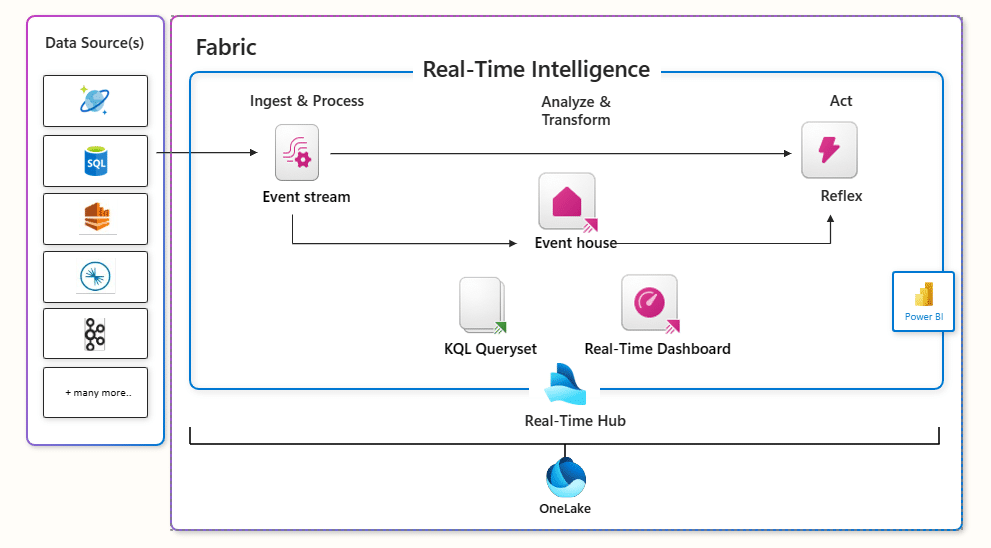The ability to make quick, informed decisions is more crucial than ever in today’s fast-paced business environment. Traditional business intelligence tools often fall short, as relying on historical data is no longer sufficient to stay competitive in a rapidly changing landscape.
Although plenty of business intelligence tools exist, Microsoft is ahead of its time. Real-time intelligence in Microsoft Fabric empowers organizations to leverage real-time business analytics in transformative ways, driving agility and smarter decision-making.
Real-Time Intelligence is an end-to-end real-time intelligence solution that allows high-speed data analysis in real-time. This dynamic solution helps organizations transform their data into an actionable resource, helping them drive value across the entire organization. As organizations embark on their digital transformation journey and deal with multiple data sources, this tool can help make faster and more fruitful decisions based on insights.
Let’s learn more about Real-Time Intelligence in Microsoft Fabric, its components within the Microsoft Fabric environment, and how it can drive value for your organization.
What is Real-Time Intelligence in Microsoft Fabric?
Real-Time Intelligence in Microsoft Fabric is a user-friendly, fully managed service that handles streaming time-series data. Built on the existing capabilities of real-time analytics and Data Activator, it offers new features that enable users of all skill levels to maximize their real-time data. With Real-Time Intelligence, you can enjoy reliable performance while searching through all kinds of data—structured, unstructured, or semi-structured—at scale. This means you can easily access the insights you need, no matter what type of data you’re working with.
It offers an end-to-end experience, allowing seamless real-time data handling without having to land in it first. It’s also an all-in-one solution for managing data from ingesting, analyzing, visualizing, monitoring, and acting on events. Whether you’re a business user, analyst, data engineer, or developer, you can quickly build solutions that pull together important signals, deliver valuable insights, and send alerts—all in real-time. This real-time capability helps teams collaborate more effectively and respond to what matters most as it happens. It makes it easier to drive meaningful results together.
Even though it’s called “real-time,” your data doesn’t need to flow at high rates or volumes to deliver real business value. Real-Time Intelligence provides event-driven, not schedule-driven, solutions, allowing you to make timely and informed decisions. Moreover, the entire Fabric suite fully integrates it, making your workflow smooth and efficient, from loading data to visualization. With Microsoft Fabric Real-Time Intelligence, you can:
- Easily ingest data from any source and in any format.
- Run analytical queries directly on raw data without building complex data models or writing scripts to transform your data.
- Import data effortlessly using default streaming, which delivers high performance and low latency for fresh data analysis.
- Benefit from by-default partitioning both time and hash-based, and by-default indexing, ensuring your data is organized and accessible.
- Work with various data structures, querying everything from structured and semi-structured data to free text.
- Query raw data without any transformation, leveraging fast response times and a wide range of available operators.
- Scale effortlessly from gigabytes to petabytes, supporting unlimited concurrent queries and users.
- Integrate seamlessly with other Microsoft Fabric workloads and tools, making your data operations even more cohesive.
Read more: An in-depth look at Microsoft Fabric unified data analytics platform.
Key components of Real-Time Intelligence in Microsoft Fabric
Microsoft Fabric’s Real-Time Intelligence relies on several fundamental components that come together to create an effective solution. These intelligence components include:

Eventhouse
Event houses serve as high-speed libraries for your data, designed to help organizations process and analyze large amounts of information quickly, particularly when fast insights are needed. They function as advanced databases capable of processing continuous data streams from multiple sources and in various formats.
As your project grows and your data needs increase, the event house scales alongside it, ensuring everything runs smoothly and efficiently without wasting resources.
KQL Database
A KQL database, or Kusto database, is a comprehensive entity that organizes a variety of data components. It houses collections of tables, stored functions, materialized views, shortcuts, and data streams, all in one place. This structure makes it easier for users to access and manage their data effectively.
KQL Queryset
The KQL Queryset lets you run queries and easily view and manipulate the results from your KQL database. With this tool, you can save your queries for later use or share them with others. It primarily uses the Kusto Query Language for creating queries, but it also supports T-SQL and some T-SQL functions.
Real-Time dashboards
Real-time dashboards enhance the efficiency of data exploration. They function like a high-performance system, enabling seamless transitions between screens and datasets without lag. This ensures a smooth and integrated user experience.
Eventsteams
Event streams in Microsoft Fabric are a user-friendly tool for managing live data effortlessly without any coding required. It gathers, transforms, and distributes data to various destinations automatically.
When you set up an event stream, you determine where the data originates (data sources), where it needs to go (destinations), and whether it requires any transformations. This process helps businesses make quick, real-time decisions by analyzing live data as it flows, which is part of Microsoft Fabric’s broader Real-Time Intelligence feature.












